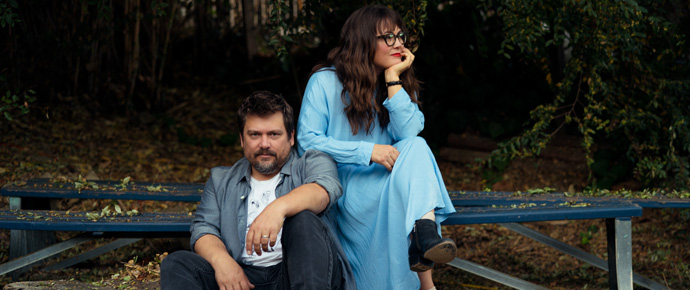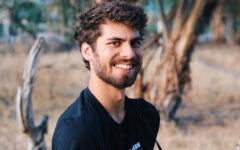
There are some artists who make it a point to expand into different realms and diversify their approach, all the while maintaining a certain solidarity with their roots by not necessarily tampering with their template.
The renowned brother sister duo Sara and Sean Watkins, who also go under the name The Watkins Family Hour, could be considered in that number. No matter where their musical ventures lead them — from their earliest endeavors as Nickel Creek, their super group of sorts, WPA, Sara’s high profile side sojourn under the aegis of I’m With Her (also featuring Sarah Jarosz and Aoife O’Donovan), Sean’s sometime project, The Fiction Family, or the various endeavors each carries out on their own — they’ve managed to retain a reverence for their bluegrass beginnings while adding new elements to the mix that allow for further daring and diversity. To a certain extent, that comes as a result of their ongoing residency at the Largo Nightclub in their native Los Angeles, where, for the past 18 years, the two have held court with a rotating cast of special musical guests.
Most recently, the pair released their sophomore album under the aegis of the Watkins Family Hour, which they appropriately titled Brother Sister. It’s another example of their ability to tap into tradition while furthering their contemporary credence, it reflects their love of the music that nurtured them early on and continues to inspire them even now. And while the pandemic has put an end to live performances — at least for the near future — the two continue to share their music in other ways, including their upcoming concert from Fanciful Fox Studios in Los Angeles, one which will be streamed for Boston’s Celebrity Series on Sunday, November 15, 2020 at 7:00 p.m. EST. The pair plan to showcase songs from the new album with support from bassist Sebastian Steinberg, and after the performance, fans will have an opportunity to chat with the artists.
This performance is Sara Watkins’ third for the Celebrity Series. She made her Celebrity Series debut in March 2016 with Patti Griffin and Anaïs Mitchell, and she later appeared with her trio, I’m With Her.
“We’ve become COVID stars,” Sean jokes. “It’s nice to have something to talk about. It’s nice to be talking about music.”
“We’ve been doing our virtual performances every two weeks, and that’s been good for us,” Sara says. “It’s given us a chance to come up with different songs to play, and to work up some new covers. We’ve been doing those shows as the Watkins Family Hour. A few festivals have also been allowing is to do virtual performances in place of actual live performances, and that’s been really nice as well. In so doing, they’ve been supporting bands and offering things to their audiences. The Celebrity Series is an incredible series as well, and we’re so glad to be a part of it, even if it’s just virtually.”
Here again, the pair find a creative connection to their bluegrass roots, not only through their love of music that’s of a certain vintage variety, but also in the communal connection that’s essential as well.
“We grew up listening to and going to bluegrass festivals,” Sara recalls. “We’d travel across the country to go to IBMA, and even as kids, we’d go to Kansas and Minnesota and Philadelphia for the folk festivals there, driving in our family minivan. I can still recall the incredible welcoming feeling of the bluegrass community, as well as the challenges of learning how to solo and sing harmony. That whole rich repertoire will always be with us. We love bluegrass music so much, and with this upcoming performance for the Celebrity Series, we will really lean on the kind of bluegrass chops that require a lot of precision in our arrangements. A lot of the early duo and solo records that have been landmarks in bluegrass — the Louvin Brothers being one example — and they’ve had a lingering impact on us, specifically when it comes to the arrangements and how to accompany one another.”
“Bluegrass is kind of a frame of mind in a way,” Sean suggests. “It’s about how you think about two-part harmony singing. Throughout the years, we may have tried different approaches and been more experimental, but there’s never been a time when we were sitting around and jamming with friends that hasn’t been awesome to us. And whenever we’ve had a chance to do that, we’ve been overjoyed. I think that’s the beauty of bluegrass — you can take it with you wherever you go. I remember watching an interview with Tim O’Brien when he said, ‘I can’t get away from bluegrass. It’s me, and everything I do is going to be identified with it because its part of my musical identity. You can try, but it’s always going to be there in some way.’ I love that idea and I love all the things you can do with it.”
Indeed, the roots dig deeper, and the Watkins not only realize and reflect that, but they celebrate it as well.
“Bluegrass isn’t just a style of music,” Sean insists. “It’s a lifestyle and tradition, and the things we learned from our elders while growing up and playing with other musicians are all built into the framework of bluegrass, more so than a lot of other kinds of music. Maybe jazz has that, but bluegrass is more than just a sound. It’s a way of looking at the music and including other people in it.”
“Growing up in Southern California, the group Bluegrass Etc. had a big influence on us,” Sara recalls. “They were really our teachers. And the artists that came down from the Bay Area — Laurie Lewis, Kathy Kallick, John Reichmann, Scott Nygard — influenced us as well. There were some great bluegrass festivals when we were growing up, and we saw all those bands that would come down to play in Southern California and the Southwest. So they were a huge influence and ringleaders of the scene.”
“Byron Berline was another one who made an impact,” Sean adds. “He was a major session player in Los Angles at the time, and he had this incredible history with the Flying Burrito Brothers and all those records he played on in the ‘70s and ‘80s. Alison Krauss was also an influential artist. When she was young, she was doing all these interesting things with bluegrass, and incorporating the pop music she grew up on, and that sort of became a template for us — maybe more than we realized. We listened to her a lot, and every now and then, when we’d see her perform, she’d bring us on stage. She ended up producing our first two records.”
He goes on to mention others iconic individuals whose impact they mined along the way as well. “Tony Rice in particular had a great impact on me, especially with the huge variety of songs he played. He was my first introduction to Randy Newman, Gordon Lightfoot, Bob Dylan…he explored a wide range of chords and melodies and harmonies in this way that seemed to fit seamlessly into what we loved about bluegrass. We also listened to the two Will the Circle Be Unbroken albums. Those were big for our family, and I remember listening to those tapes in our motorhome when we were driving to different festivals. I’d hear the conversations they recorded between takes, and think, ‘Oh my gosh, this is what it’s like in the studio!’ We were getting a feel for what it was like to be in the room. That was the thing that gave me my first visual of what it’s like to be in a studio as a professional musician.”
Indeed, their ideas — and ideals — developed from there, as Sean is quick to confirm.
“We would also really absorb all that stuff that we heard in Southern California and later, at the IBMA,” he remembers. “All of us kids loved Lonesome River Band, and we would play their versions of all these standard songs using the same arrangements. They were a big influence in some specific ways. They were very traditional, but they were also doing stuff that was nontraditional. They had this really aggressive side, but lyrically, they were a little more modern, and that’s what attracted us to them.”
Sara says that growing up in the fertile Southern California music scene had a profound impact on them as well. “There was a lot of overlap, especially with the people that played places like the Troubadour in LA,” she explains. “It was a really fascinating time. Chris Hillman had a lot to do with that, especially when he was with the Byrds. They were like the American Beatles and they were huge at the time. And then you see what Chris Hillman has done since then, and what a versatile musician he is. The stuff that he’s done has played a huge role in shaping American music.”
“Oftentimes, when people are asked about their influences, they tend to name their favorite musicians, but those may or may not be the people who had the most influence on you,” Sean reflects. “We would see a band, but we may not have heard their records. They might not have even made records, but they had a huge impact on us all the same. It’s fun to realize the stuff that actually gets in there and sticks with you. But beyond that, the people that we started getting into was Strength in Numbers, and the group that recorded the album Uncommon Ritual, which was Béla Fleck, Mike Marshall and Edgar Meyer. There were these groups that consisted of these Nashville session musicians who were doing incredible things with bluegrass instruments. That stuff was really the second wave of stuff that shaped us. And then, we went back and started digging into the early stuff, and the traditional stuff, and really appreciating artists like Del McCoury and Ralph Stanley.”
In that regard, both Watkins acknowledge that there’s a certain amount of fluidity that allows them to make music together, while also venturing out on their own when their muse encourages them to do so. It allows for a certain verve and versatility that expands the individual parameters, without feeling threatened that any essential relationship may be damaged in the process.
“That’s the thing that we first noticed about bluegrass music early on,” Sara notes. “It’s something that everyone does. Even when you have a steady gig, you’re always playing with other people, and that may develop into an album or a tour. Tim O’Brien is a perfect example. He’ll sit with in everyone, but the question never comes up, like ‘why doesn’t he just pick a band?’ That’s the norm in bluegrass, so it makes perfect sense that we would do that as well.”
“There’s another world where someone like Beyonce might do a solo record away from Destiny’s Child and it becomes like, ‘Oh well, that’s the end of that thing,'” Sean suggests. “With bluegrass, of course you do a solo record. Everybody has multiple solo records and side projects, and a lot of that has to do with the nature of the business side. Of course you have to have a lot of irons in the fire to make some money. That was always our framework, and whenever one of us wanted to do a solo record, it was never like, ‘uh oh, they’ve gone solo!’ It just always made a lot of sense for us, and in the process, it helps relieve a lot of tension. If you have some songs that don’t fit within the framework of the band, you can still do them on your own or in the context of another band.”
Inevitably, that leads to the subject of Nickel Creek. The band recently released a live album through Bandcamp that was recorded at the Fox Theater in Oakland California during the group’s last reunion tour in 2014. In addition, re-releases on the band’s first three studio albums —Nickel Creek, This Side, and Why Should the Fire Die — are also due for imminent rerelease, given the fact that they’ve been out of print on vinyl for quite some tine.
“The record company put them out,” Sean says. “They printed them up and they ended up selling really well, which was a pleasant surprise. We were going to do some Nickel Creek shows this year, but in light of the fact that live shows aren’t happening anywhere, and realizing that we had all our shows recorded from that last tour, we realized that it would probably be a good time to release that live album.”
“I think Nickel Creek will do some stuff in the future,” Sara muses. “There’s no reason not to do something. There’s no master scheme with a timeline that suggests we’ll do it in five years, but I don’t think it will even take that long.”
Tickets for the digital concert presented by the Celebrity Series are $20, and available online. A recording of the premiere stream in its entirety will be available for on demand viewing approximately one hour after the initial premiere stream ends, and will be available to view for 72 hours.
Those interested will be able to log in and watch any missed portions of the performance, and the stream is available worldwide to all.







